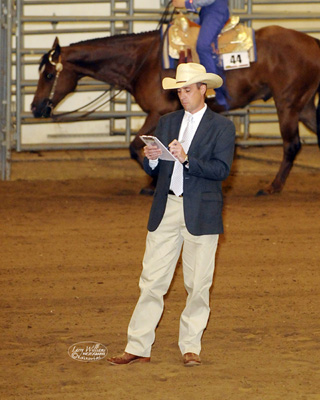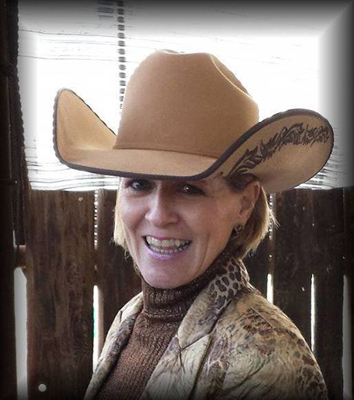
David J. Denniston, Ph.D. creator of Horseshowpatterns.com and associate professor at Colorado State University
“Let’s be honest, Horsemanship patterns are mini Reining patterns,” says Abi Buckwalter, of Westminster, Maryland.
As an Amateur rider this year who competes at American Quarter Horse Association sanctioned shows, Buckwalter earned her youth superior in horsemanship and finished 12th at the 2013 Built Ford Tough AQHA Youth World Championship and the 2013 All-American Quarter Horse Congress in Horsemanship.
Today’s Horsemanship patterns include every maneuver possible sometimes requiring a rider to perform the same element more than once. Riders are asked to spin, back-up, gallop, lope slow circles, execute lead changes, extend the jog, and more.
“In my opinion the objective of a well-designed Horsemanship pattern should be an accurate test for each exhibitor to show off their riding skills while performing prescribed maneuvers within each pattern designed by the judge or show management,” says Cyndi Hershey-Brown, a judge for APHA, AQHA, NSBA, NRHA, NRCHA and USEF events.
Designed to evaluate a rider’s ability to execute a set of maneuvers in concert with their horse, a Horsemanship pattern is scored based on precision and smoothness while the rider maintains a balanced and fundamentally correct body position. The 2014 AQHA rulebook explains, “the ideal Horsemanship pattern is extremely precise with the rider and horse working in complete unison, executing each maneuver with subtle aids and cues.”
“As a judge, I myself would say position of the rider and again the horse and rider working as a team are most important,” explains David J. Denniston, Ph.D. creator of Horseshowpatterns.com and associate professor at Colorado State University.
Each exhibitor should know their horse’s and their own strengths and weaknesses and ride the pattern with precision while using appropriate aids and cues as described in their association or club’s rulebook.
When performed perfectly, even a Horsemanship pattern can draw hoots and hollers from the stands.
“It was so challenging to go from a fast lope to a collected because you have to find that happy medium where you wow the downward transition to the collection, but not too much so that you don’t break to a trot,” Buckwalter says, “I love when you do it so well that the entire coliseum of people whistles and you know you don’t have that many fans.”
The Evolution of Horsemanship
Fundamentally, the objective of a Horsemanship class, which places the best riders at the top of the class based on the competitor’s skills as demonstrated through a set pattern has remained the same over the past few decades.
However, what has changed is the level of both the horse and rider’s ability.
“We have bred for superior equine athletes and we have excellent trainers and coaches in the industry to guide their students,” Hershey-Brown says.
Horsemanship patterns have evolved in degree of difficult as riders and horses have advanced in skill and ability. “Today’s patterns are designed to challenge a rider who considers themselves a Horsemanship rider,” says Darlene Trein, AQHA Professional Horsewoman of Trein Training Center in Seville, Ohio.
The class has become extremely specialized asking riders to execute more than straight lines of travel or round circles. “You better be prepared to show your skills riding on squares, through U-turns, in gallops transitions to a slower gait and lead changes,” she added.
Denniston predicts that as horses become increasingly talented and trainers train exhibitors who are more skilled, Horsemanship patterns will continue to develop and challenge the industry with additional elements and an increase in degree of difficulty.
Design Detail

Cyndi Hershey-Brown, a judge for APHA, AQHA, NSBA, NRHA, NRCHA and USEF events.
Pattern designers and judges are granted the creative license to sketch a pattern as they see fit as long as it meets the specific association or clubs rules and is appropriate for the level of rider in the class.
“Everyone laughs at me about this, but I find inspiration for Horsemanship patterns everywhere,” says Shelly de Barbanson, APHA’s Director of Youth and Amateur Activities, “I look at shapes that are interesting and make patterns out of them. I’ll be sitting in traffic starring at a Toyota symbol, driving by the new Jack in the Box sign….”
She strives to include elements in patterns that allow an exhibitor to truly demonstrate their abilities.
“I think in Horsemanship the speed changes and transitions have become a large part of patterns lately and allows a rider to show off that they can execute a degree of difficulty in maneuvering,” she adds.
For other pattern designers, inspiration comes from a more traditional source…watching go’s at horse shows.
“I spend hours watching past videos from World Shows and watching the best exhibitors perform and come up with new ideas for patterns and elements,” Denniston says.
He prefers to design patters that flow.
“I don’t typically choose or design patterns that have a lot of stop and go. One year at the Congress, I suggested a change to a pattern that made a pattern have more flow and was able to watch the actual class and was very pleased with how the pattern rode and received several compliments on the pattern,” he says.
Judges and show committees who may not have the time to draw a pattern of their own can consult with professionals like Denniston who provides an assortment of patterns to choose from on his website, horseshowpatterns.com. Developed from his experiences as the horse judging coach at Colorado State University, horseshowpatterns.com is a database of patterns that judges or show managers can select and use for an upcoming event. “We rely on our judges to choose patterns that fit the “legality” of the association/club and the level for which they are judging,” Denniston says.
What many trainers and riders may not realize is that once a pattern is designed and is confirmed to meet the association’s rules, show officials must determine if the pattern can be performed in the arena. Large shows like the All-American Quarter Horse Congress patterns have to be performed in one of three different pens, each of differing sizes. “(The show committee) requests patterns from the judges and then they go measure to be sure it fits in the arena,” Trein says.
Marissa Ledford riding for Oklahoma State’s Equestrian Team
Practice Makes Perfect
A winning Horsemanship ride is precise. Precision can only be mastered with repetition and time in the saddle. With so many maneuvers packed into a horsemanship pattern it can be somewhat overwhelming at the start. Breaking the pattern into smaller pieces and mastering one element at a time can serve as a solid foundation for success.
“I first worked on my body position. I rode without stirrups to school my legs and worked on keeping my arms and shoulders square,” says Marissa Dalton Ledford, an AQHA Amateur rider who also competed on the Oklahoma State University Equestrian Team. “Once I had that mastered it was one less thing I had to worry about.”
Visual reminders can emphasize a rider’s strengths and weaknesses helping them perfect their body position. “We have a wall of mirrors in our arena and that talks more than we do,” Trein added. Short video clips taken on a cell phone can also be a helpful tool for studying and improving a rider’s equitation.
Schooling one element at a time is key for achieving correctness, which is more important than speed. “The spins don’t have to be as fast as a bolt of lightning, but they should be correct,” Trein emphasized.
Staying in shape is also important. “Working on the physicality of the pattern classes is very important. Becoming a top rider is physically demanding so you might want to do exercises to prepare your body for the task at hand,” Hershey-Brown suggests.
Before heading off to a show, study the Horsemanship section of the appropriate association’s rule book.
“There are guidelines for every class in the breed rulebooks and exhibitors are responsible for knowing these rules while showing because the judges are placing the class from their observation while using rule application,” Hershey-Brown adds.
Fortunately, many shows publish their horsemanship patterns in advance of the event.
“The patterns are so involved that it’s easier if you can run through the pattern before a show,” Trein says, “even if you pre-school over the phone with your trainer, you’ll have it in your mind.”
In situations where you don’t have a chance to review the pattern ahead of time, don’t panic.
“I read over the pattern several times drawing it out in the air,” says Ledford. Be sure to read every line of the written instructions. “Sometimes I forget to read the last line, which usually tells you how to exit,” she says, “that could mean the difference of winning or not, being called back for a finals or not.”
When it’s finally show time, be confident. “When you “march” in to the pen, you should catch the judge’s eye,” Buckwalter says, “they can watch mediocre goes all day and want to fall asleep… when you walk in the ring you should have a confidence level that they can’t help but look at you and wake up.”


You must be logged in to post a comment Login